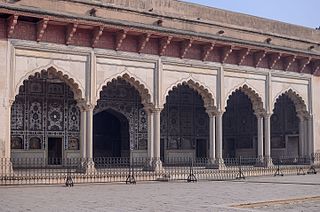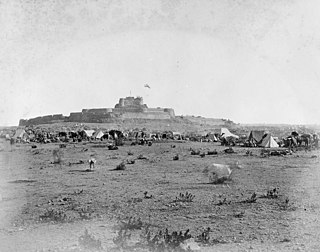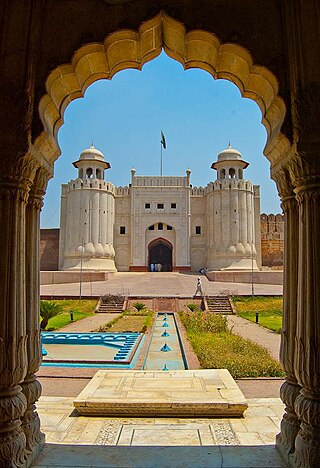
Srinagar is a city in Indian-administered Jammu and Kashmir in the disputed Kashmir region. It is the largest city and summer capital of Jammu and Kashmir, which is an Indian-administered union territory. It lies in the Kashmir Valley along the banks of the Jhelum River, and the shores of Dal Lake and Anchar Lakes, between the Hari Parbat and Shankaracharya hills. The city is known for its natural environment, various gardens, waterfronts and houseboats. It is also known for traditional Kashmiri handicrafts like the Kashmir shawl, papier-mâché, wood carving, carpet weaving, and jewel making, as well as for dried fruits. It is the second-largest metropolitan area in the Himalayas.

The Lahore Fort is a citadel in the city of Lahore in Punjab, Pakistan. The fortress is located at the northern end of Walled city of Lahore and spreads over an area greater than 20 hectares. It contains 21 notable monuments, some of which date to the era of Emperor Akbar. The Lahore Fort is notable for having been almost entirely rebuilt in the 17th century, when the Mughal Empire was at the height of its splendor and opulence.

The Sheesh Mahal is a palace located within the Shah Burj block in northern-western corner of Lahore Fort. It was constructed under the reign of Mughal Emperor Shah Jahan in 1631–32, with some additions later under Sikh Maharaja Ranjit Singh. The ornate white marble pavilion is inlaid with pietra dura and complex mirror-work of the finest quality. The hall was reserved for personal use by the imperial family and close aides. It is among the 21 monuments that were built by successive Mughal emperors inside Lahore Fort, and forms the "jewel in the Fort’s crown." As part of the larger Lahore Fort Complex, it has been inscribed as a UNESCO World Heritage Site since 1981.

Sardar Mohammad Azim Khan Barakzai was a Pashtun noble who served as Afghan governor of Kashmir (1812–1819). He was the second son of the Barakzai chief Payinda Sarfaraz Khan, while his elder brother Fateh Khan was kingmaker and Vizier to Mahmud Shah Durrani. He was one of 21 brothers from eight mothers including his half-brother Dost Mohammad Khan who would later become Emir of Afghanistan.

Dal is a lake in Srinagar, the summer capital of the Indian-administered Jammu and Kashmir in the disputed Kashmir region. It is an urban lake, the second largest lake in Jammu and Kashmir, and the most visited place in Srinagar by tourists and locals. It is integral to tourism and recreation in the Kashmir valley and is variously known as the "Lake of Flowers", "Jewel in the crown of Kashmir" or "Srinagar's Jewel". The lake is also an important source for commercial operations in fishing and water plant harvesting.

The Sikh Empire was a regional power based in the Punjab region of the Indian subcontinent. It existed from 1799, when Maharaja Ranjit Singh captured Lahore, to 1849, when it was defeated and conquered by the British East India Company in the Second Anglo-Sikh War. It was forged on the foundations of the Khalsa from a collection of autonomous misls. At its peak in the 19th century, the empire extended from Gilgit and Tibet in the north to the deserts of Sindh in the south and from the Khyber Pass in the west to the Sutlej in the east as far as Oudh. It was divided into four provinces: Lahore, which became the Sikh capital; Multan; Peshawar; and Kashmir from 1799 to 1849. Religiously diverse, with an estimated population of 4.5 million in 1831, it was the last major region of the Indian subcontinent to be annexed by the British Empire.

Hari Singh Nalwa was Commander-in-chief of the Sikh Khalsa Fauj, the army of the Sikh Empire. He is known for his role in the conquests of Kasur, Sialkot, Attock, Multan, Kashmir, Peshawar and Jamrud. Hari Singh Nalwa was responsible for expanding the frontier of Sikh Empire to beyond the Indus River right up to the mouth of the Khyber Pass. At the time of his death, the western boundary of the Empire was Jamrud.

Hari Parbat, also called Koh-i-Maran, is a hill overlooking Srinagar, the largest city and the capital of Jammu and Kashmir, India. It is the site of the Hari Parbat fort, built by the Durrani Empire, and of a Hindu temple, mosques, and gurdwara.

The Battle of Jamrud was fought between the Emirate of Afghanistan under Emir Dost Mohammad Khan and the Sikh Empire under Maharaja Ranjit Singh on 30 April 1837. Afghan forces confronted the Sikh forces at Jamrud. The garrisoned army was able to hold off the Afghans till Sikh reinforcements arrived to relieve them.

The Jamrud Fort is located beside Bab-e-Khyber at the entrance to the Khyber Pass from the Peshawar side in the tribal district of Khyber KPK, Pakistan. After death of Sardar General Hari Singh Nalwa, Khalsa Sarkar Wazir Jawahar Singh nominated Sardar General Gurmukh Singh Lamba as chief administrative and military commander to restore and consolidate the Khalsa army gains. General Sardar Gurmukh Singh Lamba was nominated as chief administrative and military commander to consolidate the gains of Khalsa Sarkar.

Poonch District was a district of the princely state of Jammu and Kashmir, which is currently divided between India and Pakistan. The Pakistani part of the erstwhile district is now the Poonch Division in the Azad Kashmir territory, whilst the Indian part of the district is the Poonch district in Jammu and Kashmir. The capital of the Pakistan-controlled side is Rawalakot; while the capital of the Indian-controlled side is Poonch.

The Battle of Attock took place on 13 July 1813 between the Sikh Empire and the Durrani Empire. The battle was the first significant Sikh victory over the Durranis.
The Battle of Shopian took place on 3 July 1819 between an expeditionary force from the Sikh Empire and Jabbar Khan, the governor of the Kashmir Valley province of the Durrani Empire. It was the decisive battle during the Sikh expedition into Kashmir in 1819.

From 1524 to 1752, Lahore was part of the Mughal Empire. Lahore touched the zenith of its glory during the Mughal rule from 1524 to 1752. The Mughals, who were famous as builders, gave Lahore some of its finest architectural monuments, many of which are extant today.

The Afghan–Sikh wars spanned from 1748 to 1837 in the Indian subcontinent, and saw multiple phases of fighting between the Durrani Empire and the Sikh Empire, mainly in and around Punjab region. The conflict's origins stemmed from the days of the Dal Khalsa, and continued after the Emirate of Kabul succeeded the Durrani Empire.

Timur Shah Durrani, also known as Timur Shah Abdali or Taimur Shah Abdali was the second ruler of the Afghan Durrani Empire, from November 1772 until his death in 1793. An ethnic Pashtun, he was the second eldest son of Ahmad Shah Durrani.

Hamza Makhdoom, popularly known as Makhdoom Sahib, was a Sufi mystic living in Kashmir. He is sometimes referred to as Mehboob-ul-Alam and Sultan-ul-Arifeen.

The Pir Panjal Pass, also called Peer Ki Gali, is a mountain pass and a tourist destination located in the Pir Panjal Range in Jammu and Kashmir, India. It connects the Kashmir Valley to the Rajouri and Poonch districts of Jammu via the Mughal Road. It is the highest point on the Mughal road at 3,490 m (11,450 ft) and lies to the southwest of the Kashmir valley.

The Subah of Lahore was a province of the Mughal Empire encompassing the central Punjab and eastern Punjab, now divided between Pakistan and India. It was created as one of the original 12 Subahs of the Mughal Empire under the administrative reforms carried by emperor Akbar in 1580. The province ceased to exist after the death of its last viceroy, Adina Beg in 1758, with large parts being incorporated into Durrani Empire. Collectively, Lahore and Multan Subahs comprised Mughal Punjab.

The Military campaigns of Hari Singh Nalwa were a series of conquests and battles in which the Sikh Empire commander Hari Singh Nalwa fought from 1807 to 1837. His first battle was fought against the Durrani Empire. With his help, the Sikh Empire managed to expand over a large land area, spanning from Jamrud to Tibet. He was killed in the battle of Jamrud at Khyber Pass in 1837.



















